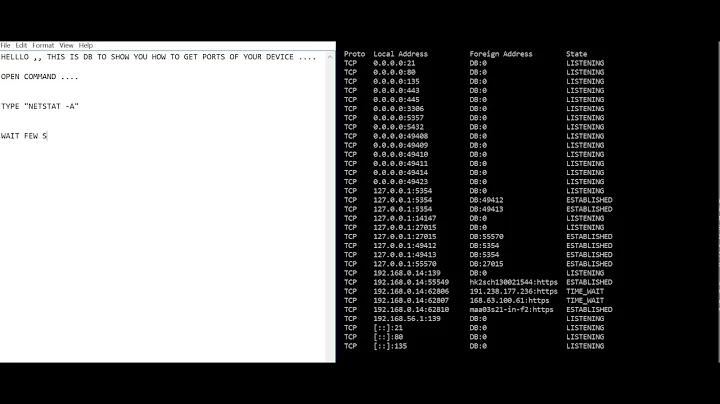How to find out what is running on localhost port
202,315
Solution 1
Run netstat -a -o | find "9090" and have a look at the far right column. That's the Process ID (PID) of the owning process. Match it up with running processes in Task Manager.
Solution 2
@Evan Anderson answer did not work for me cause I got a message
FIND: Parameter format not correct
so I replaced the Find call with a powershell Select-String
netstat -aon|sls 61456
TCP 127.0.0.1:61456 0.0.0.0:0 LISTENING 31796
finally I open Task manager and looked sort the PID column looking for 31796
Update
Usually I want to kill these processes so here a powershell script that does not need manual intervention
netstat -aon|sls 5000|%{("$_".substring("$_".LastIndexOf(' '))).Trim()}|%{
$id=$_
Get-Process|?{$_.id -eq $id}
}|Stop-Process
Related videos on Youtube
Author by
BanksySan
Updated on September 18, 2022Comments
-
BanksySan over 1 year
I have something running at port 9090 on my local machine.
It's probably something I set up long ago and forgot about... how can I find out what it is?
I am using Windows 8.
-
 Ryan Ries about 10 yearsIt's
Ryan Ries about 10 yearsIt'snetstat -b, but this question is off topic because it does not appear to relate to professional systems administration.
-
-
user32882 over 6 yearsIf I try this I do get a process id on the fa right column but no process exists in the task manager with exactly that ID. the ID for me is 15936 but in the process manager the PID's go ....,15792, 15904, 16080,... if I arrange them in ascending order....How to fix this please? I then tried
tasklist /fi "pid eq 15936"and gotINFO: No tasks are running which match the specified criteria -
 Eugen Sunic almost 4 yearsit gives me netstat: illegal option -- o
Eugen Sunic almost 4 yearsit gives me netstat: illegal option -- o -
Evan Anderson almost 4 years@eugene_sunic - What version of Windows are you doing this on? AFAIK this argument has been in Windows since at least Windows XP, and still works fine in currently-shipping versions of Windows.





